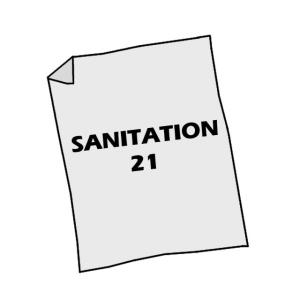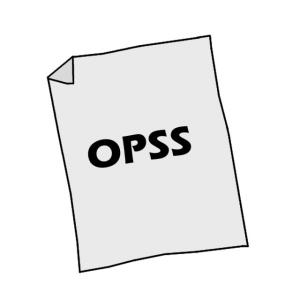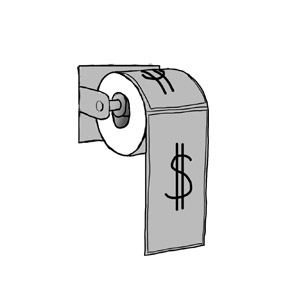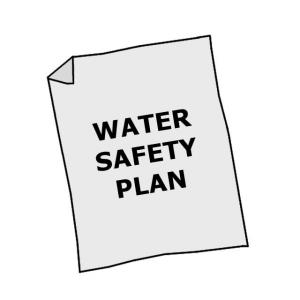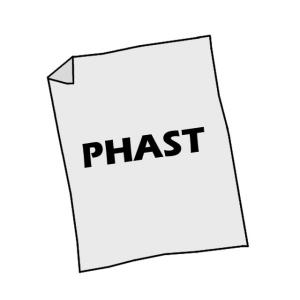Executive Summary
A trickling filter, is a fixed-bed, biological reactor that operates under (mostly) aerobic conditions. Pre-settled wastewater is continuously ‘trickled’ or sprayed over the filter. As the water migrates through the pores of the filter, organics are aerobically degraded by the biofilm covering the filter material.
| In | Out |
|---|---|
Faceal Sludge, pre-treated Blackwater or Fertigation water |
Introduction
The trickling filter is filled with a high specific surface area material, such as rocks, gravel, shredded PVC bottles, or special pre-formed plastic filter media. A high specific surface provides a large area for biofilm formation. Organisms that grow in the thin biofilm over the surface of the media oxidise the organic load in the wastewater to carbon dioxide and water, while generating new biomass.
The incoming pre-treated wastewater is ‘trickled’ over the filter, e.g., with the use of a rotating sprinkler. In this way, the filter media goes through cycles of being dosed and exposed to air. However, oxygen is depleted within the biomass and the inner layers may be anoxic or anaerobic.
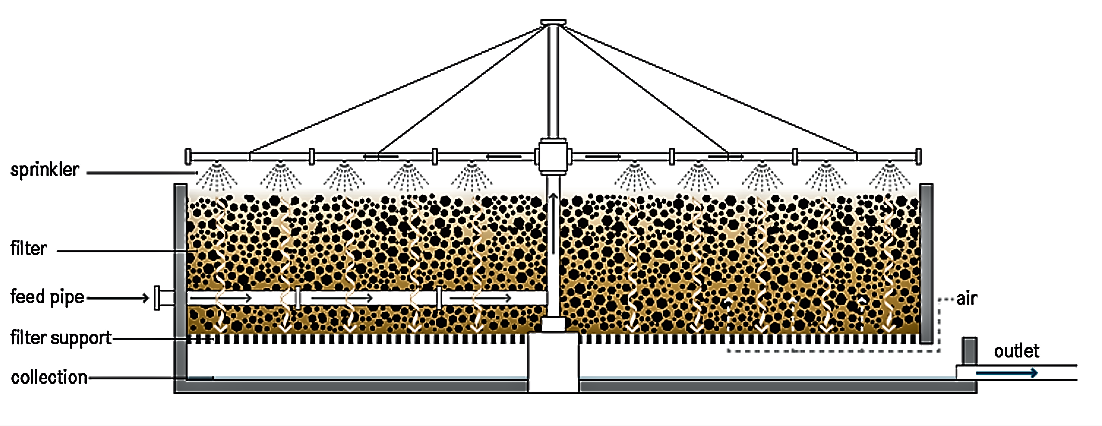
Design Considerations
The filter is usually 1 to 2.5 m deep, but filters packed with lighter plastic filling can be up to 12 m deep.
The ideal filter material is low-cost and durable, has a high surface to volume ratio, is light, and allows air to circulate. Whenever it is available, crushed rock or gravel is the cheapest option. The particles should be uniform and 95% of them should have a diameter between 7 and 10 cm. A material with a specific surface area between 45 and 60 m2/m3 for rocks and 90 to 150 m2/m3 for plastic packing is normally used. Larger pores (as in plastic packing) are less prone to clogging and provide for good air circulation. Primary treatment is also essential to prevent clogging and to ensure efficient treatment.
Adequate air flow is important to ensure sufficient treatment performance and prevent odours.
The underdrains should provide a passageway for air at the maximum filling rate. A perforated slab supports the bottom of the filter, allowing the effluent and excess sludge to be collected. The trickling filter is usually designed with a recirculation pattern for the effluent to improve wetting and flushing of the filter material.
With time, the biomass will grow thick and the attached layer will be deprived of oxygen; it will enter an endogenous state, will lose its ability to stay attached and will slough off. High-rate loading conditions will also cause sloughing. The collected effluent should be clarified in a settling tank to remove any biomass that may have dislodged from the filter. The hydraulic and nutrient loading rate (i.e., how much wastewater can be applied to the filter) is determined based on the characteristics of the wastewater, the type of filter media, the ambient temperature, and the discharge requirements.
Health Aspects/Acceptance
Odour and fly problems require that the filter be built away from homes and businesses. Appropriate measures must be taken for pre- and primary treatment, effluent discharge and solids treatment, all of which can still pose health risks.
Operation and Maintenance
A skilled operator is required to monitor the filter and repair the pump in case of problems. The sludge that accumulates on the filter must be periodically washed away to prevent clogging and keep the biofilm thin and aerobic. High hydraulic loading rates (flushing doses) can be used to flush the filter. Optimum dosing rates and flushing frequency should be determined from the field operation.
The packing must be kept moist. This may be problematic at night when the water flow is reduced or when there are power failures.
Snails grazing on the biofilm and filter flies are well known problems associated with trickling filters and must be handled by backwashing and periodic flooding.
This technology can only be used following primary clarification since high solids loading will cause the filter to clog. A low-energy (gravity) trickling system can be designed, but in general, a continuous supply of power and wastewater is required.
Compared to other technologies (e.g., Waste Stabilization Ponds), trickling filters are compact, although they are still best suited for peri-urban or large, rural settlements.
Wastewater Engineering, Treatment and Reuse
Trickling Filters
Short Factsheet on the applicability and design criteria of trickling filters including a lot of information on operation and maintenance (form the United States Environment Protection Agency (EPA).
U.S. EPA (2000): Trickling Filters. (= Wastewater Technology Fact Sheet, EPA 832-F , 14 ). United States Environment Protection Agency URL [Accessed: 03.06.2019]
